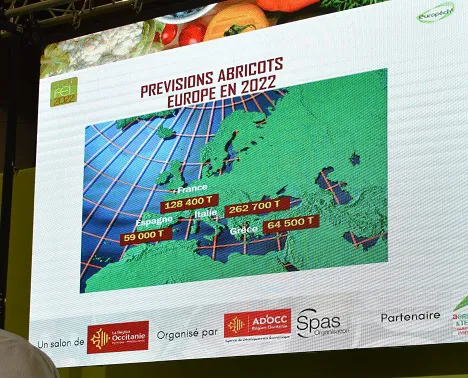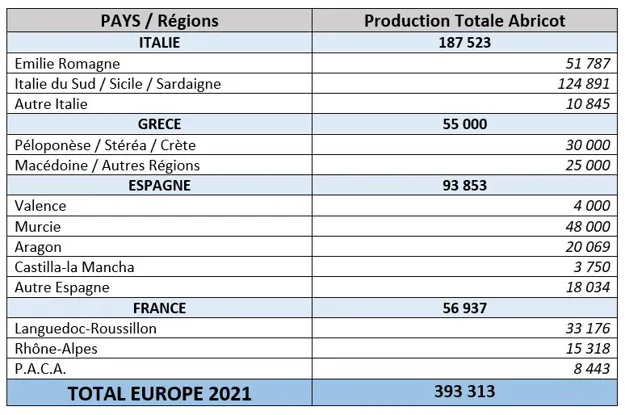If 2021 was a very complicated year for apricots, with frosts affecting all European production areas and causing large production losses, and with weather conditions not very favorable to the consumption of summer fruits, the year 2022 should be more favorable with a lower intensity of frosts, except for Spain, which suffered from important climatic hazards this year.
The forecasts are based on the production of the 4 main producing countries and are realized thanks to the partnership established with the local organizations of the different countries.

The forecasts were led by Eric Hostalnou (Chamber of Agriculture of the Pyrénées-Orientales) with Georges Kantzios of the ASEPOP Cooperative for Greece, Laura Stocchi and Thomas Bosi of CSO Italy,
Santiago Vazquez from the Federation of Spanish Agricultural Cooperatives, Manel Simon director of AFRUCAT (Association of Fruit Producers of Catalonia), Bruno Darnaud, president of the PDO Peaches and Apricots of France and Jean Pratx for Le Verger Bio de Véronique.

Reminder for the year 2021:

France: "decent" production level for 2022, with an increase of 125% compared to 2021
57,000 T in 2021, the lowest production in the last 30 years. Among the most affected regions: Rhône-Alpes with up to 80% losses in some areas. Other regions, such as Roussillon and Gard, managed to save part of the fruit with losses ranging from 50 to 60%.
Although this year's frost was significant, its intensity did not match that of 2021. Some areas were nevertheless affected like certain hillsides of the Rhone valley, in Ardeche, the upper valley of the Têt, and the Baronnies region which was again strongly impacted this year.
The 2022 production should therefore be around 130,000 T (128,400 T to be exact), an increase of 125% compared to 2021 and an increase of 8% compared to the 2016/20 average. "This is a decent level but still below the production potential."
Details by region for 2022:
- Languedoc Roussillon: 41,464 T
- Rhône Alpes : 67 400 T
- P.A.C.A : 19 500 T
Spain: a strongly impacted production, down 37% compared to 2021
Climatic problems have been multiplying in Spain for nearly 4 years. In 2020, Spanish production reached 100 000 T, 93 000 T in 2021. The year 2022 promises to be catastrophic with barely 60 000 T, i.e. a decrease of 37% compared to last year, which already had a deficit of 52% compared to the 2016/2020 average.
Production 2022 in detail by region:
- Valencia: 2,300 T
- Murcia: 40,000 T
- Aragon: 2,988
- Castilla La Mancha: 2,500 T
- Catalonia: 2,970 T
- Other regions: 8,253 T
Italy: 40% increase in production compared to 2021
In 2021, the frost affected all production areas, from the North to the South, with a production of 188,000 tons. This year, forecasts are calling for a production of 262,700 T, up 40% compared to 2021, and 11% compared to the 2016/20 average.
Details by region for 2022:
- Emilia Romagna: 77,498 T
- Southern Italy, Sicily, Sardinia: 159,472 T
- Other regions: 25,716 T
Greece: production 17% higher than in 2021
In 2021, apricot production reached 55,000 T, a decrease of 29% compared to 2020 and 23% compared to the 2015/19 average. If producers had managed to secure good prices, the production loss was not compensated.
The year 2022 looks better but the production is still lower than a normal year with 64 500 T, an increase of 17%. The early varieties, all production zones included, are the most affected by the low temperatures and the frosts. No damage was reported for late varieties.
The forecast for Greece is 64,500 T, up 17% compared to the 2021 harvest but 20% below the 2016/20 average.
Details by region:
- Peloponese / Sterea / Crete: 30,000 T
- Macedonia / Other regions: 34 500 T
The European forecasts for peaches and nectarines will be communicated on May 24!
